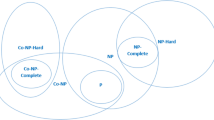Abstract
Historically, the wrapping effect was discovered and named in the context of solving ordinary initial value problems in interval arithmetic. Its explanation was obviously geometric: rotations of interval vectors enclosing the set of solutions catch excessive points into the enclosure which may eventually ‘explode’ exponentially. Also discrete dynamical systems share this undesirable behaviour. In the literature the wrapping effect has been discussed primarily in this context.
Access this chapter
Tax calculation will be finalised at checkout
Purchases are for personal use only
Preview
Unable to display preview. Download preview PDF.
Similar content being viewed by others
References
Alefeld, G., Herzberger, J.: An Introduction to Interval Computations. Academic Press, New York, 1983.
Anguelov, R., Markov, S.: Wrapping effect and wrapping function. Reliab. Comput. 4, No.4, 311–330 (1998).
Berz, M.: Verified integration 01 ODEs and fiows using differential algebraic methods on high-order Taylor models. Reliab. Comput. 4, No.4, 361–369 (1998).
Eijgenraam, P.: The Solution 01 Initial Value Problems Using Interval Arithmetic. Math. Centre Tracts 144, Mathematisch Centrum, Amsterdam (1981).
Gambill, T.N. Skeel, R.D.: Logarithmic Reduction 01 the Wrapping Effect with Applications to Ordinary Differential Equations. SIAM J. Numer. Anal. 25, 153–162 (1988).
Jackson, L.W.: Interval Arithmetic Error-Bounding Algorithms. SIAM J. Numer. Anal. 12, 223–238 (1975).
Kühn, W.: Rigorously Computed Orbits 01 Dynamical Systems Without the Wrapping Effect. Computing 61, No. 1, 47–67 (1998).
Kühn, W.: Zonotope Dynamics in Numerical Quality Control. In: Hege, H-Ch. (ed.) et al.: Mathematical visualization. Algorithms, applications, and numerics. International workshop Visualization and mathematics, Berlin, Germany, September 16-19, 1997. Berlin: Springer. 125-134 (1998).
Kühn, W.: Towards an Optimal Control of the Wrapping Effect. In: Csendes, Tibor (ed.), Developments in reliable computing. SCAN-98 conference, 8th international symposium on Scientific computing, computer arithmetic and validated numerics. Budapest, Hungary, September 22-25, 1998. Dordrecht: Kluwer Academic Publishers. 43-51 (1999).
Lohner, R.J.: Enclosing the Solutions of Ordinary Initial- and Boundary- Value Problems. In: Kaucher, E., Kuliseh, U., Ullrich Ch. (eds.): Computerarithmetic, pp. 225–286, Teubner Stuttgart (1987).
Lohner, R.J.: Einschlie-ung der Lösung gewöhnlicher Anfangs- und Randwertaufgaben und Anwendungen. Dissertation, University of Karlsruhe (1988).
Lohner, R.J.: Verified Computing and Programs in Pascal-XSC. Habilitationsschrift, University of Karlsruhe (1994).
Makino, K, Berz, M.: Efficient control of the dependency problem based on Taylor model methods. Reliab. Comput. 5, No. 1, 3–12 (1999).
Moore, R.E.: Automatie local coordinate transformations to reduce the growth of error bounds in interval computation of solutions of ordinary differential equations. Error in Digital Comput. 2, Proe. Symp. Madison 1965, 103–140 (1965).
Moore, R.E.: Interval Analysis. Englewood Cliffs, N.J. Prentice-Hall (1966).
Nedialkov, N.S., Jackson, KR., Corliss, G.F.: Validated solutions of initial value problems for ordinary differential equations. Appl. Math. Comput. 105, No. 1, 21–68 (1999).
Nedialkov, N.S., Jackson, KR.: A New Perspective on the Wrapping Effect in Interval Methods for Initial Value Problems for Ordinary Differential Equations. This Volume. (2001)
Neumaier, A.: Interval methods for systems of equations. Encyclopedia of Mathematics and its Applications, 37. Cambridge etc.: Cambridge University Press. xvi, (1990).
Neumaier, A.: The Wrapping Effect, Ellipsoidal Arithmetic, Stability and Confidence Regions, Computing, Suppl. 9, 175–190 (1993).
Nickel, K: How to fight the wrapping effect. Lect. Notes Comput. Sei. 212, 121–132 (1986).
Rall, L.B.: Automatie Differentiation: Techniques and Applications. Lecture Notes in Computer Science, No. 120, Springer-Verlag, Berlin, 1981.
Stewart, N.P.: A heuristic to reduce the wrapping effect in the numerical solution ofx’ = f(t, x). BIT 11, 328–337 (1971).
Author information
Authors and Affiliations
Editor information
Editors and Affiliations
Rights and permissions
Copyright information
© 2001 Springer-Verlag Wien
About this chapter
Cite this chapter
Lohner, R.J. (2001). On the Ubiquity of the Wrapping Effect in the Computation of Error Bounds. In: Kulisch, U., Lohner, R., Facius, A. (eds) Perspectives on Enclosure Methods. Springer, Vienna. https://doi.org/10.1007/978-3-7091-6282-8_12
Download citation
DOI: https://doi.org/10.1007/978-3-7091-6282-8_12
Publisher Name: Springer, Vienna
Print ISBN: 978-3-211-83590-6
Online ISBN: 978-3-7091-6282-8
eBook Packages: Springer Book Archive




